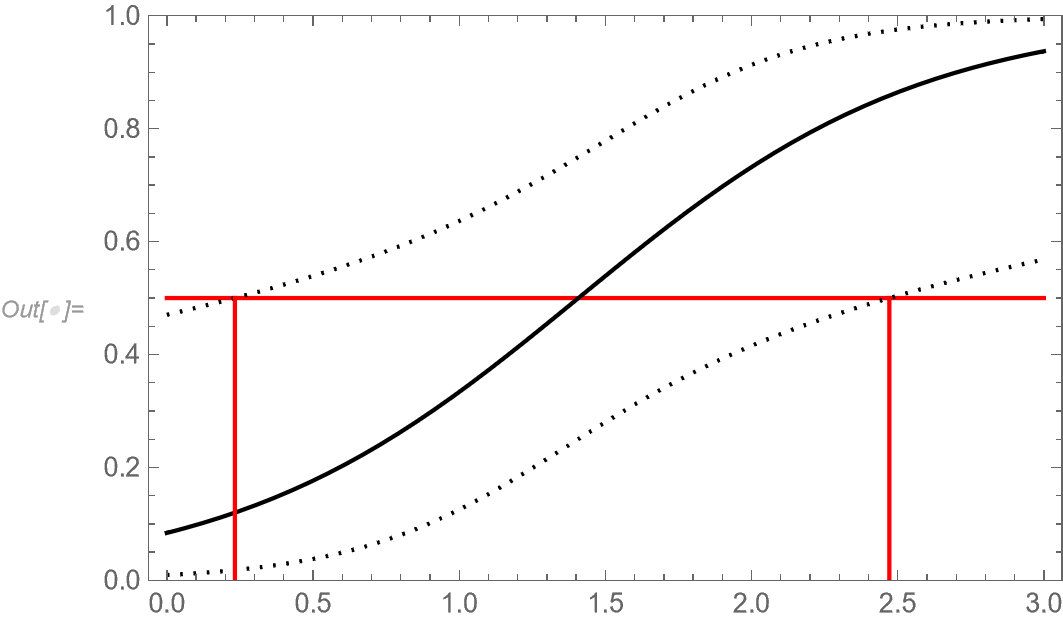Background
I have a set of binary test data of the form
data1 = {{0., 0.}, {0., 0.}, {0., 0.}, {0.5, 0.}, {0.5, 0.}, {0.5, 1.}, {1., 1.}, {1., 0.}, {1., 0.}, {1.5, 1.}, {1.5, 0.}, {1.5, 1.}, {2., 0.}, {2., 0.}, {2., 1.}, {2.5, 1.}, {2.5, 1.}, {2.5, 1.}, {3., 1.}, {3., 1.}, {3., 1.}} For convenience I will refer to the numbered pairs as $\{x_i,y_i\}$. Here $x_i$ can be e.g. velocity and $y_i$ can be hit $(1)$ or miss $(0)$. The dataset is just an example, so keep in mind that the sample size might be a bit small to obtain nice curve fits.
Since the data is binary it makes sense to perform a logistic regression. I will denote the first parameter (intercept) as $\alpha$ and the second parameter (gradient) as $\beta$. I can obtain such a fit by writing
logit = LogitModelFit[data1, x, x]; I can then plot my result and get various properties
Show[ListPlot[data1], Plot[logit[x], {x, Min[data1[[All, 1]]] - 1,Max[data1[[All, 1]]] + 1}], PlotRange -> All] Normal[logit] logit["ParameterConfidenceIntervalTable"] logit["CovarianceMatrix"] // MatrixForm logit["Properties"] A related post: How can I compute and plot the 95% confidence bands for a fitted logistic regression model? nicely covers how to obtain 95% confidence intervals for the output probabilities, i.e. the $y_i$.
Question
However, there are situations where it is e.g. interesting to have the corresponding 95% confidence intervals for all the $x_i$ data values instead. My question is how can we calculate the 95% confidence interval for all of the $x_i$ data?
Attempts
1
My first thought was that this could be obtained by simply writing something like
cov = logit["CovarianceMatrix"]; SE = Sqrt[{1,x}.cov.{1,x}]; xLower = x - 1.96*SE; xUpper = x + 1.96*SE; for an individual $x_i$. However, I suspect the interpretation of the standard error (SE above) is then actually the standard error in the sum $\alpha + \beta x$.
2
Next I guessed that what I actually need is the standard error of an individual $x_i$, such that I can still write something like this:
xLower = x - 1.96*SE; xUpper = x + 1.96*SE; for an individual $x_i$. My first thought was to pick the standard error as $\text{SE} = 1/\beta$ as this represents the width of the logistic distribution function as explained here https://stats.stackexchange.com/questions/403575/how-is-logistic-regression-related-to-logistic-distribution as well as in other references. My issue with this is of course that the confidence interval is constant, regardless of which $x_i$ are actually measured. I would imagine the confidence interval to be slimmer around $x_i$ with many datapoints, and thicker around $x_i$ with fewer datapoints.
3
I run into the same sort of issue (constant width of confidence interval) if I solve the inequality $$\alpha + \beta x - 1.96 \sqrt{(1,x).\text{cov}.(1,x)}<\alpha + \beta x < \alpha + \beta x + 1.96 \sqrt{(1,x).\text{Cov}.(1,x)}$$ with respect to $x$.
Question
So to reiterate my question is: what is the proper way to calculate a reasonable behaved 95% confidence interval for the datapoints $x_i$ for a logistic distribution in mathematica?

